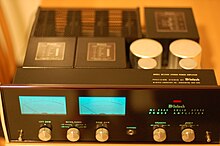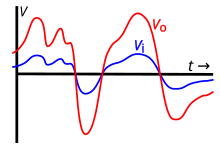
Back Verstärker (Elektrotechnik) ALS مضخم إلكتروني Arabic Amplificador electrónicu AST Elektron gücləndirici Azerbaijani Электронны ўзмацняльнік Byelorussian বিবর্ধক Bengali/Bangla Amplificador electrònic Catalan Zesilovač Czech Elektronisk forstærker Danish Verstärker (Elektrotechnik) German


An amplifier, electronic amplifier or (informally) amp is an electronic device that can increase the magnitude of a signal (a time-varying voltage or current). It is a two-port electronic circuit that uses electric power from a power supply to increase the amplitude (magnitude of the voltage or current) of a signal applied to its input terminals, producing a proportionally greater amplitude signal at its output. The amount of amplification provided by an amplifier is measured by its gain: the ratio of output voltage, current, or power to input. An amplifier is defined as a circuit that has a power gain greater than one.[2][3][4]
An amplifier can be either a separate piece of equipment or an electrical circuit contained within another device. Amplification is fundamental to modern electronics, and amplifiers are widely used in almost all electronic equipment. Amplifiers can be categorized in different ways. One is by the frequency of the electronic signal being amplified. For example, audio amplifiers amplify signals in the audio (sound) range of less than 20 kHz, RF amplifiers amplify frequencies in the radio frequency range between 20 kHz and 300 GHz, and servo amplifiers and instrumentation amplifiers may work with very low frequencies down to direct current. Amplifiers can also be categorized by their physical placement in the signal chain; a preamplifier may precede other signal processing stages, for example,[5] while a power amplifier is usually used after other amplifier stages to provide enough output power for the final use of the signal. The first practical electrical device which could amplify was the triode vacuum tube, invented in 1906 by Lee De Forest, which led to the first amplifiers around 1912. Today most amplifiers use transistors.
- ^ HiFi-Wiki webpage with facsimile of data sheet
- ^ Crecraft, David; Gorham, David (2003). Electronics, 2nd Ed. CRC Press. p. 168. ISBN 978-0748770366.
- ^ Agarwal, Anant; Lang, Jeffrey (2005). Foundations of Analog and Digital Electronic Circuits. Morgan Kaufmann. p. 331. ISBN 978-0080506814.
- ^ Glisson, Tildon H. (2011). Introduction to Circuit Analysis and Design. Springer Science and Business Media. ISBN 978-9048194438.
- ^ Patronis, Gene (1987). "Amplifiers". In Glen Ballou (ed.). Handbook for Sound Engineers: The New Audio Cyclopedia. Howard W. Sams & Co. p. 493. ISBN 978-0-672-21983-2.


